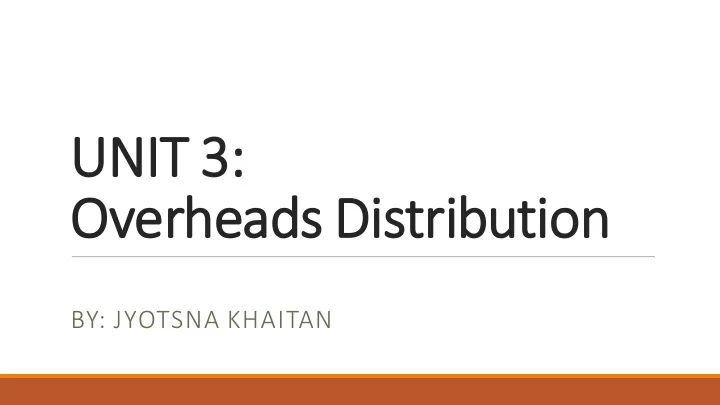

UNIT IT 3: Overheads Distribution BY: JYOTSNA KHAITAN
Direct and indirect expenses: 1.Direct expenses are expenses that can be directly identified with a specific cost unit or cost center. There are few examples of direct expenses but royalties paid to a designer or fees paid to a subcontractor for a specific job could be classed as direct expenses. • Direct expenses are part of the PRIME COST of a product. 2.Indirect expenses cannot be directly identified with a specific cost unit or cost center. • For example, the cost of renting a factory where shirts are manufactured is classified as an indirect cost because it would be impossible to relate such costs to shirts only, if other clothes, such as dresses and suits were also made in the same factory. • Indirect expenses are also known as OVERHEADS.
Inter-department service: (As we did a practical question before the holidays; we learned how service department costs are Apportioned over other production departments.) In case service departments render services to each other, the service department costs are charged to each other on reciprocal basis. These costs are also called Reciprocal-costs. The inter-service distribution of the reciprocal-costs can be done by using any of the three methods: 1. Simultaneous Equation method 2. Repeated Distribution method 3. Trial & Error method
(1) Simultaneous Equation method: In this method we construct simultaneous-equations to solve the problem of distribution of cost among themselves simultaneously. Question 1:
Answer: Overhead Distribution Summary Production department Service Dept Items of expenses Amount A B C X Y (Rs.) (Rs.) (Rs.) (Rs.) (Rs.) (Rs.) 1.Rent 1,000 200 400 150 150 100 2.Electricity 200 50 80 30 20 20 3.Fire Insurance 400 80 160 60 60 40 4.Plant Depreciation 4,000 1,000 1,500 1,000 300 200 5.Transport 400 50 50 50 100 150 Rs. 6,000 1,380 2,190 1,290 630 510
Items of expenses Amt Production Production Production Service dept X Service dept Y (Rs.) dept A dept B dept C (Rs.) (Rs.) (Rs.) (Rs.) (Rs.) 1)Rent 1,000 200 400 150 150 100 2)Electricity 200 50 80 30 20 20 3)Fire Insurance 400 80 160 60 60 40 4)Plant Depreciation 4,000 1,000 1,500 1,000 300 200 5)Transport 400 50 50 50 100 150 Rs. 6,000 1,380 2,190 1,290 630 510 6)Service dept X apportioned (30:40:20:00:10) --- 224 299 149 -747 75 Rs. 6,000 1,604 2,489 1,439 -117 585 7)Service dept Y apportioned (10:20:50:20:00) --- 59 117 292 117 -585 Rs. 6,000 1,663 2,606 1,731 --- --- 8)Estimated working hours 1,000 2,500 1,800 1,663 2,606 1,731 9)OVERHEAD RATES per hour ÷ ÷ ÷ {Total expenses ÷ Number Of hours} 1,000 2,500 1,800 = = = 1.663 1.042 0.961
Calculations: Simultaneous equations; Let X = total expenses of service department D to be apportioned And Y = total expenses of service department E to be apportioned Therefore; X = 630 + 20% of Y , And Y = 510 + 10% of X Solving the two equations simultaneously we get; X = 747 Y= 585
(2) REPEATED DISTRIBUTION METHOD: According to this method the percentages given in the question are used and service department expenses are apportioned repeatedly, till the total costs of service departments are exhausted. Using the same question let us solve it with the repeated distribution method. The end result will tally with the results of simultaneous equation method.
Solution : Overhead distribution summary Items Production dept Production dept Production dept Service Service A B C dept X dept Y Total departmental expenses 1,380 2,190 1,290 630 510 1st Distribution: 189 252 126 -630 63 Overheads of service dept X apportioned (Rs. 630) 2nd Distribution: 57 115 286 115 -573 Overheads of service dept Y apportioned (Rs. 510+63) 3 rd Distribution: 35 46 23 -115 11 Overheads of service dept X apportioned (Rs. 115) 4 th Distribution: 1 2 6 2 -11 Overheads of service dept Y apportioned (Rs. 11) 5 th Distribution: 1 1 - -2 - Overheads of service dept X apportioned (Rs. 2) TOTAL OVERHEADS 1,663 2,606 1,731 - -
(3) Trial & Error Method : In this method the cost of one service center is apportioned to another service center plus the share received from the first cost center is again apportioned to the first cost center. This process is continued till the amount to be apportioned becomes nil.
Items Prod Prod Prod Service Service dept A dept B dept C dept X dept Y Total Departmental Expenses 1,380 2,190 1,290 630 510 1 st Distribution: Costs of service dept X apportioned to Y (10% of 630) 63 2 nd Distribution: 573 Costs of service dept Y apportioned to X (20% of 573) 115 3 rd Distribution: Additional costs of service dept X apportioned to Y (10% of 12 115) 4th Distribution: Additional costs of service dept Y apportioned to X(@0% of 12) 2 Total 1,380 2,190 1,290 747 585 90% of total overheads of Dept X charged to dept A,B,C (remaining 10% has already been charged to dept Y and is included in Rs. 585) in the given ratio of 30%,40%,20% 224 299 149 80% of total overheads of Dept Y charged to dept A,B,C (remaining 20% has already been charged to dept X and is included in Rs. 747) in the given ratio of 10%,20%,50% 59 117 292 TOTAL OVERHEADS 1,663 2,606 1,731
Recommend
More recommend